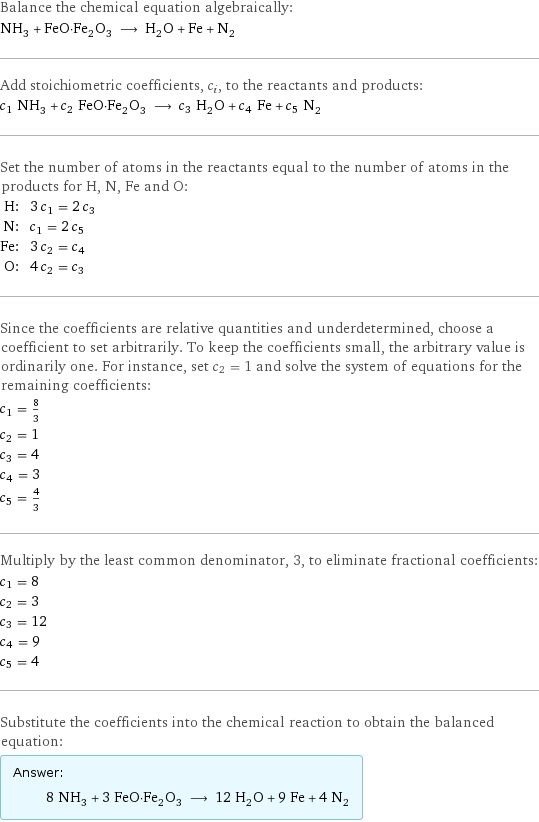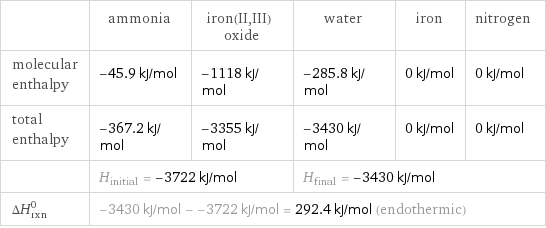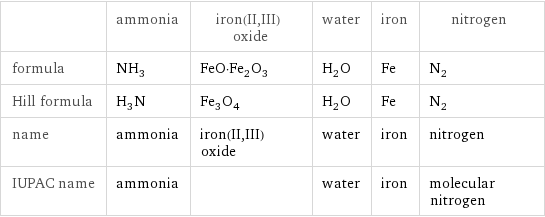Input interpretation

NH_3 ammonia + FeO·Fe_2O_3 iron(II, III) oxide ⟶ H_2O water + Fe iron + N_2 nitrogen
Balanced equation

Balance the chemical equation algebraically: NH_3 + FeO·Fe_2O_3 ⟶ H_2O + Fe + N_2 Add stoichiometric coefficients, c_i, to the reactants and products: c_1 NH_3 + c_2 FeO·Fe_2O_3 ⟶ c_3 H_2O + c_4 Fe + c_5 N_2 Set the number of atoms in the reactants equal to the number of atoms in the products for H, N, Fe and O: H: | 3 c_1 = 2 c_3 N: | c_1 = 2 c_5 Fe: | 3 c_2 = c_4 O: | 4 c_2 = c_3 Since the coefficients are relative quantities and underdetermined, choose a coefficient to set arbitrarily. To keep the coefficients small, the arbitrary value is ordinarily one. For instance, set c_2 = 1 and solve the system of equations for the remaining coefficients: c_1 = 8/3 c_2 = 1 c_3 = 4 c_4 = 3 c_5 = 4/3 Multiply by the least common denominator, 3, to eliminate fractional coefficients: c_1 = 8 c_2 = 3 c_3 = 12 c_4 = 9 c_5 = 4 Substitute the coefficients into the chemical reaction to obtain the balanced equation: Answer: | | 8 NH_3 + 3 FeO·Fe_2O_3 ⟶ 12 H_2O + 9 Fe + 4 N_2
Structures

+ ⟶ + +
Names

ammonia + iron(II, III) oxide ⟶ water + iron + nitrogen
Reaction thermodynamics
Enthalpy

| ammonia | iron(II, III) oxide | water | iron | nitrogen molecular enthalpy | -45.9 kJ/mol | -1118 kJ/mol | -285.8 kJ/mol | 0 kJ/mol | 0 kJ/mol total enthalpy | -367.2 kJ/mol | -3355 kJ/mol | -3430 kJ/mol | 0 kJ/mol | 0 kJ/mol | H_initial = -3722 kJ/mol | | H_final = -3430 kJ/mol | | ΔH_rxn^0 | -3430 kJ/mol - -3722 kJ/mol = 292.4 kJ/mol (endothermic) | | | |
Equilibrium constant
![Construct the equilibrium constant, K, expression for: NH_3 + FeO·Fe_2O_3 ⟶ H_2O + Fe + N_2 Plan: • Balance the chemical equation. • Determine the stoichiometric numbers. • Assemble the activity expression for each chemical species. • Use the activity expressions to build the equilibrium constant expression. Write the balanced chemical equation: 8 NH_3 + 3 FeO·Fe_2O_3 ⟶ 12 H_2O + 9 Fe + 4 N_2 Assign stoichiometric numbers, ν_i, using the stoichiometric coefficients, c_i, from the balanced chemical equation in the following manner: ν_i = -c_i for reactants and ν_i = c_i for products: chemical species | c_i | ν_i NH_3 | 8 | -8 FeO·Fe_2O_3 | 3 | -3 H_2O | 12 | 12 Fe | 9 | 9 N_2 | 4 | 4 Assemble the activity expressions accounting for the state of matter and ν_i: chemical species | c_i | ν_i | activity expression NH_3 | 8 | -8 | ([NH3])^(-8) FeO·Fe_2O_3 | 3 | -3 | ([FeO·Fe2O3])^(-3) H_2O | 12 | 12 | ([H2O])^12 Fe | 9 | 9 | ([Fe])^9 N_2 | 4 | 4 | ([N2])^4 The equilibrium constant symbol in the concentration basis is: K_c Mulitply the activity expressions to arrive at the K_c expression: Answer: | | K_c = ([NH3])^(-8) ([FeO·Fe2O3])^(-3) ([H2O])^12 ([Fe])^9 ([N2])^4 = (([H2O])^12 ([Fe])^9 ([N2])^4)/(([NH3])^8 ([FeO·Fe2O3])^3)](../image_source/b417ca52a4f17a8d393f42e0860cde43.png)
Construct the equilibrium constant, K, expression for: NH_3 + FeO·Fe_2O_3 ⟶ H_2O + Fe + N_2 Plan: • Balance the chemical equation. • Determine the stoichiometric numbers. • Assemble the activity expression for each chemical species. • Use the activity expressions to build the equilibrium constant expression. Write the balanced chemical equation: 8 NH_3 + 3 FeO·Fe_2O_3 ⟶ 12 H_2O + 9 Fe + 4 N_2 Assign stoichiometric numbers, ν_i, using the stoichiometric coefficients, c_i, from the balanced chemical equation in the following manner: ν_i = -c_i for reactants and ν_i = c_i for products: chemical species | c_i | ν_i NH_3 | 8 | -8 FeO·Fe_2O_3 | 3 | -3 H_2O | 12 | 12 Fe | 9 | 9 N_2 | 4 | 4 Assemble the activity expressions accounting for the state of matter and ν_i: chemical species | c_i | ν_i | activity expression NH_3 | 8 | -8 | ([NH3])^(-8) FeO·Fe_2O_3 | 3 | -3 | ([FeO·Fe2O3])^(-3) H_2O | 12 | 12 | ([H2O])^12 Fe | 9 | 9 | ([Fe])^9 N_2 | 4 | 4 | ([N2])^4 The equilibrium constant symbol in the concentration basis is: K_c Mulitply the activity expressions to arrive at the K_c expression: Answer: | | K_c = ([NH3])^(-8) ([FeO·Fe2O3])^(-3) ([H2O])^12 ([Fe])^9 ([N2])^4 = (([H2O])^12 ([Fe])^9 ([N2])^4)/(([NH3])^8 ([FeO·Fe2O3])^3)
Rate of reaction
![Construct the rate of reaction expression for: NH_3 + FeO·Fe_2O_3 ⟶ H_2O + Fe + N_2 Plan: • Balance the chemical equation. • Determine the stoichiometric numbers. • Assemble the rate term for each chemical species. • Write the rate of reaction expression. Write the balanced chemical equation: 8 NH_3 + 3 FeO·Fe_2O_3 ⟶ 12 H_2O + 9 Fe + 4 N_2 Assign stoichiometric numbers, ν_i, using the stoichiometric coefficients, c_i, from the balanced chemical equation in the following manner: ν_i = -c_i for reactants and ν_i = c_i for products: chemical species | c_i | ν_i NH_3 | 8 | -8 FeO·Fe_2O_3 | 3 | -3 H_2O | 12 | 12 Fe | 9 | 9 N_2 | 4 | 4 The rate term for each chemical species, B_i, is 1/ν_i(Δ[B_i])/(Δt) where [B_i] is the amount concentration and t is time: chemical species | c_i | ν_i | rate term NH_3 | 8 | -8 | -1/8 (Δ[NH3])/(Δt) FeO·Fe_2O_3 | 3 | -3 | -1/3 (Δ[FeO·Fe2O3])/(Δt) H_2O | 12 | 12 | 1/12 (Δ[H2O])/(Δt) Fe | 9 | 9 | 1/9 (Δ[Fe])/(Δt) N_2 | 4 | 4 | 1/4 (Δ[N2])/(Δt) (for infinitesimal rate of change, replace Δ with d) Set the rate terms equal to each other to arrive at the rate expression: Answer: | | rate = -1/8 (Δ[NH3])/(Δt) = -1/3 (Δ[FeO·Fe2O3])/(Δt) = 1/12 (Δ[H2O])/(Δt) = 1/9 (Δ[Fe])/(Δt) = 1/4 (Δ[N2])/(Δt) (assuming constant volume and no accumulation of intermediates or side products)](../image_source/4ee0e68d3ddd3c0bc711a2f3f284ca09.png)
Construct the rate of reaction expression for: NH_3 + FeO·Fe_2O_3 ⟶ H_2O + Fe + N_2 Plan: • Balance the chemical equation. • Determine the stoichiometric numbers. • Assemble the rate term for each chemical species. • Write the rate of reaction expression. Write the balanced chemical equation: 8 NH_3 + 3 FeO·Fe_2O_3 ⟶ 12 H_2O + 9 Fe + 4 N_2 Assign stoichiometric numbers, ν_i, using the stoichiometric coefficients, c_i, from the balanced chemical equation in the following manner: ν_i = -c_i for reactants and ν_i = c_i for products: chemical species | c_i | ν_i NH_3 | 8 | -8 FeO·Fe_2O_3 | 3 | -3 H_2O | 12 | 12 Fe | 9 | 9 N_2 | 4 | 4 The rate term for each chemical species, B_i, is 1/ν_i(Δ[B_i])/(Δt) where [B_i] is the amount concentration and t is time: chemical species | c_i | ν_i | rate term NH_3 | 8 | -8 | -1/8 (Δ[NH3])/(Δt) FeO·Fe_2O_3 | 3 | -3 | -1/3 (Δ[FeO·Fe2O3])/(Δt) H_2O | 12 | 12 | 1/12 (Δ[H2O])/(Δt) Fe | 9 | 9 | 1/9 (Δ[Fe])/(Δt) N_2 | 4 | 4 | 1/4 (Δ[N2])/(Δt) (for infinitesimal rate of change, replace Δ with d) Set the rate terms equal to each other to arrive at the rate expression: Answer: | | rate = -1/8 (Δ[NH3])/(Δt) = -1/3 (Δ[FeO·Fe2O3])/(Δt) = 1/12 (Δ[H2O])/(Δt) = 1/9 (Δ[Fe])/(Δt) = 1/4 (Δ[N2])/(Δt) (assuming constant volume and no accumulation of intermediates or side products)
Chemical names and formulas

| ammonia | iron(II, III) oxide | water | iron | nitrogen formula | NH_3 | FeO·Fe_2O_3 | H_2O | Fe | N_2 Hill formula | H_3N | Fe_3O_4 | H_2O | Fe | N_2 name | ammonia | iron(II, III) oxide | water | iron | nitrogen IUPAC name | ammonia | | water | iron | molecular nitrogen